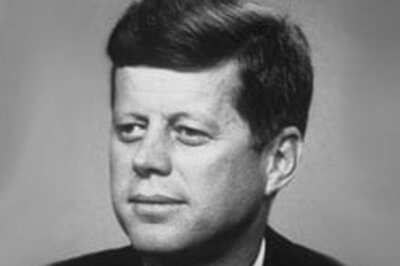
views
How many times over the course of our lives have we come to regret a certain choice we made, or had counterfactual thoughts of ‘what if…’? Plenty, right? We are quick to fall victim to the fundamental attribution error and hold ourselves in great esteem for positive outcomes, while we hold others or external factors responsible for negative outcomes. Perhaps what is needed is that we take a step back and understand that we are active agents in the constructions of our lives and that the social world we engage with is a gigantic intersection of socio-economic, political, and historical phenomena that have converged to create the world we currently live in. We are all gears in the construction of this world and each gear plays a different role as a stakeholder in the collective reality that we all experience.
Lifespan development, the first paradigm, clearly, is centred on the understanding that we humans grow in a bio-psycho-social manner throughout our lives. The interplay of changing social contexts and surroundings intersects with our individual adjustments to these social changes that help us grow.
The second paradigm, a rather important one at that, is that of the role of agency. Agency is essentially the autonomy that rests within each one of us and the ability to make choices that eventually lead to certain life outcomes. Individuals construct their own lives through their choices and actions at each step of their lives, based on the opportunities or situational constraints they may find themselves in.
The third paradigm, regarding time and place, is another paramount consideration when it comes to our lives, as even one second or centimetre here or there has the potential to profoundly change everything.
The fourth paradigm pertaining to timing highlights how the timing of when a developmental change occurs alters the life experience of an individual.
Lastly, we arrive at the fifth paradigm, regarding that of linked lives. While we live our lives independently, they interdependently shape others’ lives as well. This is perhaps the most prominent of the five paradigms that are noticeable in the 2016 film Lion, since at each step of the way, one life was influencing those of many others.
Human lives are inexplicably complex and intricate; the social sciences dedicate themselves to understanding human lives and the social world we experience, but the rapidity of the evolution of our species and technology makes it extremely difficult for scholars to understand what ‘life’ is all about.
The life course perspective, however, makes things a little more comprehensible for us. The life course perspective, drawing from a variety of fields such as sociology, psychology, history, philosophy, and social demography, and by virtue of this interdisciplinarity, understands human lives in a more holistic manner.
The life course attempts to trace and understand life trajectories and the ways in which we transition from one stage to the next in our lives, also invariably transforming the social world around us. The challenge, however, is to arrive at a baseline understanding of ‘normal’ based on which we identify and label people and situations as socially deviant. Lion is a fitting media example, and via the life story of the protagonist Saroo, helps us gain insight into the role of subjective experiences and contexts in an individual’s life, that eventually compound to produce future outcomes. The plot of the film revolves around Saroo’s life, who at the young age of five gets lost in a location far away from his hometown, and eventually ends up in Australia, seeking his roots two decades later.
The five paradigms’ principle is the basic introductory framework that we shall use to analyse the film, which talks about lifespan development, the role of agency, the role of time and place, timing, and linked lives.
The first paradigm talks of lifespan development. With reference to Saroo, the film traces his development throughout the years, beginning from when he was five and knew nothing of the world, to when he was 25, and travels across continents to meet his biological mother. It also showcases how his thinking and way of viewing the world had changed. When his social context changed from his hometown Ganestalay to Bengal, where he got lost, he could not keep up with the change, communicate effectively, or navigate himself through the situations he encountered. However, as he grew up and revisited his hometown as an adult, the communication gap between his Hindi-speaking mother and his English-bred self did not pose a problem in understanding each other’s feelings.
Shortly after being lost, Saroo is sent to Australia to be adopted by a couple. An interesting concept employed here is that of social pathways. Social pathways are essentially the socially constructed and normatively accepted ways of and timings of doing things. For instance, entering school at the age of Five or six is considered ‘normal’ and something most people follow in a uniform manner. None of us would consider getting lost at the age of five and getting sent to a foreign land as an adoptee as ‘normal’.
However, the interesting part about the film is that although Saroo did not have an ordinary childhood that followed the regular social pathway as a child, his Australian parents provided him with education and resources in a way that streamlined his deviant childhood into a normative adulthood. Thus, while lifespan development is always taking place for everyone, it may or may not take place at a constant pace for all individuals or the same life stages for all individuals.
The second paradigm is the role of agency. This is illustrated in the film at several points, including when Saroo exercises his agency by choosing to run away from the band of child traffickers at the station where he gets lost, and also at times chooses not to exert his agency when he is being sent to Australia. He accepts what is happening to him and does not resist being groomed to align with Australian customs and being sent overseas. At 25, he chooses to re-express his agency and actively chooses to devote his time and efforts to search for his biological mother and hometown.
Taking a step away from Saroo, we must also take into account the agency of the Australian couple who chose to adopt rather than have children of their own, despite being able to conceive and having all the resources at their disposal. They exerted their agency in an informed and conscious manner, knowing it would alter not only their lives but also of the children to whom they were about to provide fresh and enriched lives.
The third paradigm is regarding time and place. There is a scene where Saroo meets a man at a restaurant who offers him food and contacts an orphanage to take him in. Had Saroo reached the restaurant even one second after the man had left, he perhaps would never have been sent to the orphanage, or even Australia at that, and chances are he would have been found. It may have been for good or for bad but setting aside the value judgment, it would have panned out very differently, for Saroo and his family. Also, because this story (based on true events), takes place at a time when technology was not as developed or as pervasive as it is today, the means of communication with his family were severely restricted to local newspapers. It was only when Google Earth was released two decades later that the search for his family became possible. Had Google Earth not been released at the time that it did, Saroo probably would not have found his home.
The fourth paradigm pertains to timing. Had Saroo been slightly older, he probably would have stayed back at home to take care of his sister and not have gotten lost in the first place. Alternatively, he would have also made it back to his home despite being lost. Saroo’s adoptive brother Mantosh, who was another child the Australian couple had adopted, had most probably suffered some trauma at an early age or had a developmental issue. He was mentally disturbed and would hit himself when he was under stress, which gives us a picture of how developmental pathways are different for different people owing to their life histories. Another aspect pertaining to time is the fact that over the course of so many years, as time passed, new experiences, thoughts, and feelings glossed over Saroo’s previous ones. Over time, he forgot how to speak Hindi at all, despite it being his first language as a child.
Lastly, the fifth paradigm is regarding linked lives. Saroo’s family was run single-handedly by a mother who laboured as a stone-picker to feed her children. The absence of a father is perhaps what might have caused Saroo to accompany his older brother Guddu to risky odd jobs. Guddu unfortunately passed away the same night Saroo got lost, and this caused their mother to live only with her daughters, for the next many years. Furthermore, Saroo getting lost is what eventually brought parenthood to the Australian couple and brotherhood to Mantosh.
With Saroo’s example, we are invoked with the understanding of how cumulative life experiences, advantages and disadvantages, intertwine and converge at various points in our lives to produce situations that either make us joyous or upset. The point of this piece is not to analyse a film but rather to learn from the virtual lives of its characters and imbibe these principles in our own lives, regardless of the hardships we may be facing. Many times, a mishap may not be anyone’s fault at all, and the blame lies with no one. It may just be an unfortunate timing when the strings of fate and various factors merge, and we may simply be caught up in the happenings of it. Hence, we must become more aware of the agency we possess and the effect our actions have on those around us, and embrace change as it occurs, as change is the only thing that is constant.
Yashee Jha, a multi-faceted student, is an avid commentator on various topical issues. Views expressed in the above piece are personal and solely those of the author. They do not necessarily reflect News18’s views.




















Comments
0 comment